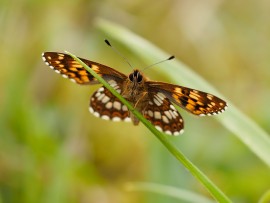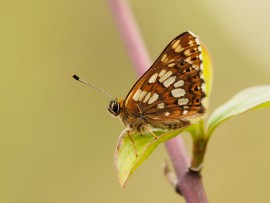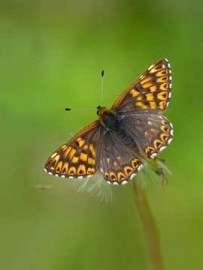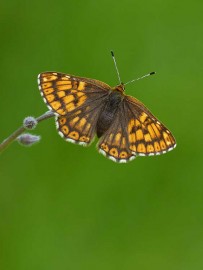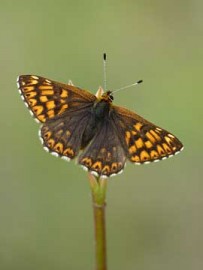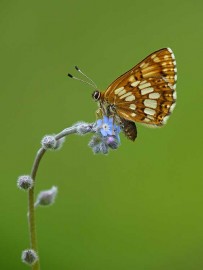by Martin Kalaher
In a by-gone age when large tracts of Sussex woodland were regularly coppiced the Duke of Burgundy was present in most of our larger woods. Unfortunately for this pretty orange-and-brown, chequered butterfly commercial coppicing fell out of favour and one-by-one the Wealden colonies were lost. In 2003, just eight individuals were recorded, and this species was rapidly heading for extinction within this county. A major conservation initiative was launched by Neil Hulme and as they say, "the rest is history". The precipitous decline of this species was reversed and nowadays in a good season the county total may exceed one thousand.
The Duke of Burgundy is the only European member of a tropical family of butterflies called metalmarks. In truth it looks like a small fritillary and indeed our ancestors referred to it as the "Duke of Burgundy Fritillary". The background colour of the upper surface of the male is a 'burnt orange', which is overlaid by a complex pattern of dark brown bars and stripes. At first glance the female appears very similar but it can be separated if we concentrate on the outer half of the forewing. The background colour in the female is a much brighter orange and the colour ratios are different with 70/30 "bright orange"/brown, compared to 50/50 "burnt orange"/brown for the male. The undersides of both sexes are similar and made up of a lovely mixture of browns and yellow ochre, with two parallel rows of pearly-white dots on the hindwing.
The flight period is from late April to mid-June, with a peak in mid-May but if the spring is colder than usual, and emergence delayed, then a few stragglers may be found into late June. As the self-contained colonies may be very small there is a risk that the sexes may have difficulty in locating each other. The males overcome this potential problem by congregating in "leks". On downland these leks may be found on the lower slopes that face west and north or in the shallow-basined combes, which tend to be very sheltered from the wind. The males spend most of their existence in dense scrub and will generally not come out unless it is sunny and there is no more than a gentle breeze. Even with excellent weather conditions they don't usually appear much before 11.0am and then disappear into scrub at around 4.0pm. Whilst on territory within the lek the close proximity of near-neighbours gives rise to frequent dog-fights, not only between the males themselves but between the males and any other insects that stray too close, regardless of the mismatch in size. They are very pugnacious little butterflies.
Once mated the females avoid the lek, wandering in search of suitable Primula species. Since in this county most colonies are found on chalk the preferred larval food plant is Cowslip but in woodland colonies the eggs may be laid on both Primrose and Cowslip. Whatever the habitat the females are very fussy and will generally only deposit their eggs on the underside of large, fleshy leaves. Therein lies the conundrum when managing a downland site for butterflies. The Duke of Burgundy requires a "scrubby grassland" in complete contrast to other chalk downland species such as Adonis Blue and Silver-spotted Skipper, which need a much shorter sward. It is one of the many challenges when managing downland sites, deciding whether or not to use grazing animals and if so, which one and for how many months of the year?
The best sites in Sussex to see this species are: Heyshott Escarpment SU899168, Springhead (Kithurst) Hill TQ070125, Chantry Hill TQ0812 and Harting Downs SU796185.



